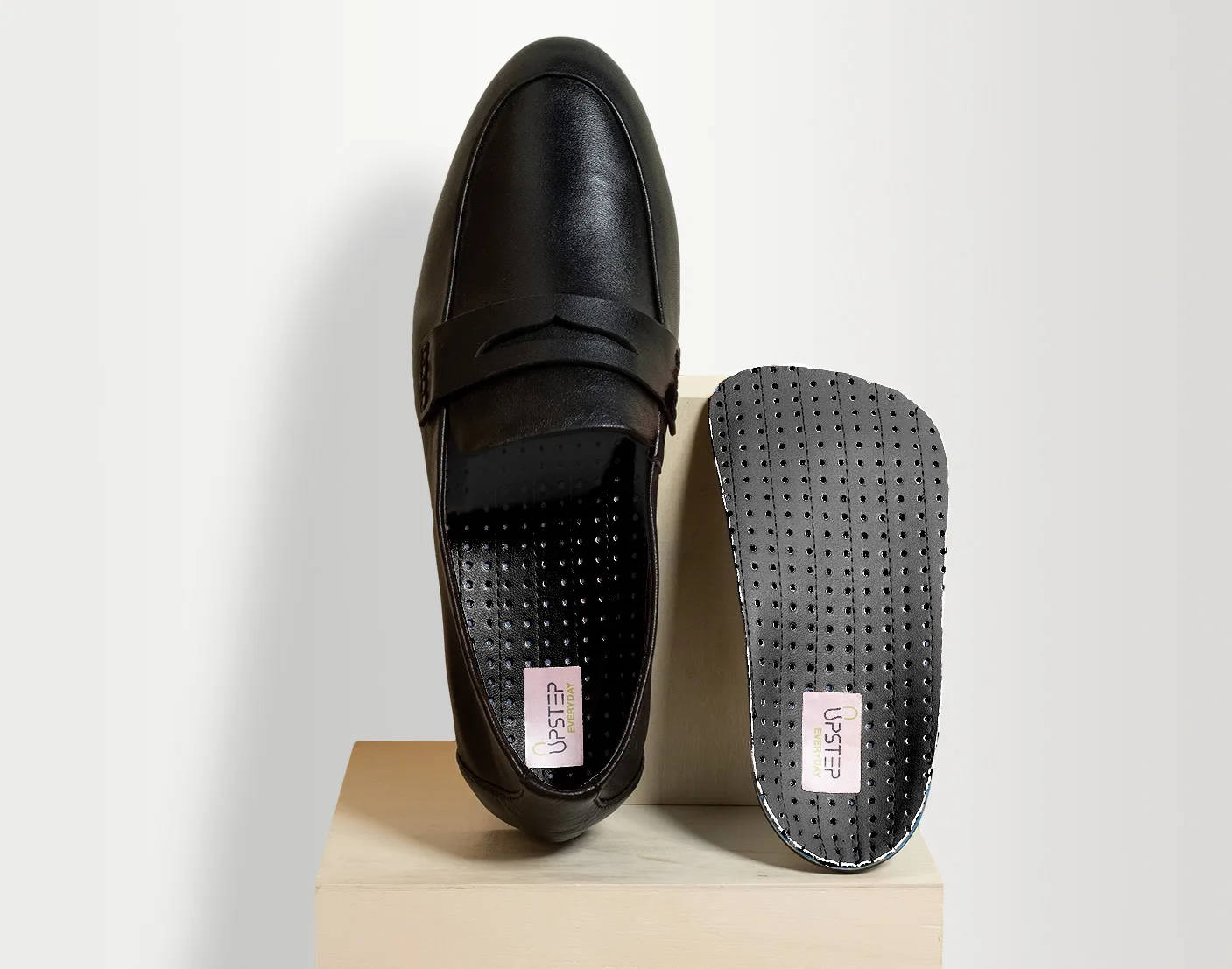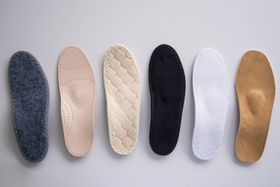Overpronation: Signs, Causes, & Treatments
Understand overpronation with insights on its signs, causes, and treatments.
Published November 10, 2024.

Many people suffer from overpronation, a foot condition that can lead to a host of painful problems, from plantar fasciitis to knee pain. This common foot ailment often goes undiagnosed or untreated, causing unnecessary discomfort and hindering daily activities.
But relief may be just a step away. Below, we examine common signs, causes, and treatment for overpronation—helping you walk pain-free again.
» Skip ahead: get custom orthotic insoles to address your overpronation
What Is Overpronation?
Overpronation is a movement pattern in which the foot rolls excessively inward when walking or running. It occurs during the foot's natural movement cycle, known as pronation, which is essential for shock absorption.
But, in cases of overpronation, the foot rolls too far inward, causing an imbalance in weight distribution. This misalignment can lead to increased stress on the foot and ankle, potentially leading to injuries such as shin splints, plantar fasciitis, or knee pain over time.
For example, a dedicated runner who logs several miles weekly might notice that her running shoes wear out unevenly, with the inner sides of the soles thinning faster than the outer edges.
They also frequently have mild knee pain, especially after long runs. After visiting a specialist, they learn that their feet roll excessively inward, causing her to overpronate. The inward rolling motion places extra pressure on her knees and ankles, causing discomfort and the wear pattern in her shoes.
Recent research has identified that women are more likely to experience overpronation as they have a higher incidence of predisposing factors than men. [1]
Pregnancy also causes ligament laxity throughout the body, as well as an increased overall weight and altered gait biomechanics. The result of this is the inward roll of the foot, resulting in overpronation. [2]
» Overpronation vs. underpronation: Check out the differences
3 Symptoms of Overpronation
Overpronation can lead to the development of pain or conditions in the foot and lower leg, such as:
1. Pain in the Arch
Pain in the arch of the foot often results from strain placed on the tendons, ligaments, and muscles supporting the arch structure. It usually happens when your foot repeatedly translates weight from heel to toe during running, jumping, or playing any sport that involves sudden changes in direction.
Let's say you're a runner training for an upcoming marathon. You decide to up the training intensity to prepare better, but all of a sudden, you sense a sharp pain. It would translate into a burning sensation that worsens after long runs, and you would feel it intensely each morning.
Supporting the foot with appropriate footwear or orthotics and focusing on strengthening exercises for the foot and ankle can help mitigate these risks.
» Did you know that collapsed arches and flat feet aren't the same?
2. Ankle Pain or Swelling
During overpronation, your foot rolls excessively inward with each step, straining the arch. This inward motion places extra pressure on the ankle, leading to inflammation and strain of the muscles, tendons, and ligaments around it. Over time, the repeated inward rotation can cause pain and swelling in the ankle due to stress injuries or microtears in supportive tissues.
A retail worker who spends long hours on their feet might notice a dull ache and mild swelling in their inner ankle, which becomes more pronounced after busy shifts. Over time, the pain would intensify, especially after they walk on hard surfaces. Their shoes would also show significant wear on the inner side of the sole, a common sign of overpronation.
» Check out our definitive guide to ankle sprains
3. Shin Splints
Shin splints, or medial tibial stress syndrome, refer to pain along the inner edge of the shinbone (tibia)—resulting from repetitive stress on the shinbone and surrounding connective tissues. Overpronation increases the chances you'll develop shin splints, especially if you're an athlete.
For example, a marathon runner might start experiencing pain along the inner edge of their shin, especially during and after their runs. As with other symptoms, their running shoes would show wear on the inner soles.
» Having lower leg pain? Heal your shin splints with targeted exercises
6 Possible Causes Behind Overpronation
1. Inherited Foot Structure
People with inherited structural characteristics like flat feet are more prone to overpronation-related issues due to the additional stress on their lower body biomechanics. They may experience conditions such as shin splints, ankle pain, and plantar fasciitis.
2. Marfan Syndrome
Marfan Syndrome is a genetic disorder affecting the body’s connective tissue, which plays a critical role in providing structure and support to various organs and systems, including the skeleton, eyes, heart, and blood vessels.
People with Marfan Syndrome often have certain physical traits, such as long limbs, flexible joints—and even flat feet or low arches. These foot structures can lead to overpronation because the connective tissue in their feet lacks the resilience needed for proper arch support.
The excessive inward roll caused by overpronation can lead to pain in the feet, ankles, and even knees, making it difficult for those with Marfan Syndrome to engage in high-impact activities without having discomfort.
» Does your pinkie toe hurt? You're maybe dealing with a Tailor's bunion
3. Ehlers-Danlos Syndrome
Ehlers-Danlos Syndrome (EDS) is a group of genetic disorders that affect connective tissue. People with EDS often have excessively flexible joints, including their ankles and feet. This condition also comes with hypermobility, which, when paired with flexibility, results in flat feet or low arches.
These factors cause the person to lack the necessary structural support to prevent overpronation. As the foot rolls inward with each step, the body places extra stress on the feet, ankles, and even the knees. The result is chronic pain, discomfort, and increased risk of injuries.
4. Down Syndrome
Down Syndrome is a genetic disorder caused by an extra copy of chromosome 21. It leads to a range of developmental and physical characteristics, including low muscle tone, joint laxity, and flat feet.
These physical traits make people with the syndrome more susceptible to overpronation, as the low muscle tone and flat arches reduce the structural support required to keep the foot in a neutral position. As a result, the foot tends to roll inward excessively when walking or running, which places extra strain on the muscles, tendons, and ligaments in the foot and ankle.
» Are your toes pointing inwards? Learn how to deal with pigeon toes
5. Muscular Dystrophies
Muscular dystrophies (MD) are a group of genetic disorders characterized by progressive weakness and degeneration of skeletal muscles, which can significantly impact mobility and physical function.
Kids with Duchenne muscular dystrophy progress through their early years, showing early signs of gait abnormalities, including overpronation. Initially, they may have a waddling gait or difficulty climbing stairs due to proximal muscle weakness. As the condition progresses, they might rely more on their hips and other stabilizing muscles to stay balanced.
6. Unsupportive Footwear
Shoes that lack adequate structural support, cushioning, and stability can significantly contribute to overpronation. You may not get the necessary support, leading to a flattening of the foot's arch. This excessive inward rolling can strain muscles, tendons, and ligaments, increasing the risk of plantar fasciitis, shin splints, and knee pain.
Most running shoes are marketed as lightweight or minimalist but lack sufficient arch support. Many runners turn to them without thinking about their foot anatomy, causing themselves problems in the long run.
For example, they might have flat feet, which means they need shoes with high arch support. Over time, this runner may experience discomfort in their feet and legs due to the added stress on their joints and muscles. They could even develop conditions such as Achilles tendinopathy or plantar fasciitis as a result of the unsupportive footwear compounding their overpronation issue.
» You can get orthotics cheap by covering them with your insurance
5 Ways to Treat Overpronation
1. Orthotic Insoles
Orthotics are a proven, effective method to stabilize your ankle joints. Their design prevents the loss of arch height and inward roll of the ankle caused by overpronation while also cushioning your foot.
Now, you might think that over-the-counter insoles provide sufficient support to help you with overpronation, but that isn't the case. These insoles are a universal solution, meant for people who want to improve comfort during everyday wear—not for addressing specific conditions.
What you need is a personalized solution.
Upstep Custom Orthotics match the unique contours of your feet, offering personalized arch support that helps distribute pressure evenly—especially useful for overpronation. They'll help you power through everything, whether it's the daily commute or a recreational football match.
The insoles are durable, too. We make them using polypropylene, a material known for its exceptional durability. Its high tensile strength allows it to withstand repeated biomechanical stress without losing its shape or structural integrity. You won't be able to wear your Upstep Insoles out, no matter if you're into heavy workouts or just have a physically demanding job.
All you need to do is:
- Take a 3-minute test and order a custom mold
- The mold will arrive at your address in 1–3 business days
- You'll imprint your feet and return the mold to us—free of charge
After 22–28 business days, we ring your doorbell and you will get a custom pair of insoles designed specifically to address your overpronation issues. Each pair is designed and produced under the watchful eye of our head of podiatrist, Philip Wells, and his team of international-level professionals.
2. Orthopedic Footwear
Orthopedic footwear refers to shoes specifically designed to support or accommodate the mechanics and structure of the foot, ankle, and leg.
For example, rocker-soled shoes have curved soles designed to facilitate movement by redistributing pressure across the foot. This design helps reduce the need for excessive foot movement, making it beneficial for people with overpronation.
Before you start looking for orthopedic shoes, you should consult a certified pedorthist or healthcare professional who can assess your foot mechanics and find any specific conditions that may require orthopedic footwear.
Based on the assessment, choose between over-the-counter or custom-made insoles shoes. Custom options may be necessary for severe conditions or specific foot shapes.
» Who would've thought? You can get amazing benefits by rolling your feet
3. Lifestyle Adjustments
Intentional lifestyle changes encompass various aspects of life, including diet, physical activity, sleep patterns, stress management, and substance use. The goal is for you to promote a healthier lifestyle.
An example of a lifestyle adjustment is improving dietary habits to lose weight and lessen the strain on your feet:
- Incorporating more fruits and vegetables into daily meals.
- Reducing processed food intake, which often contains high levels of sugars and unhealthy fats.
- Practicing portion control to avoid overeating.
To start, reflect on your current habits and determine which areas (diet, exercise, sleep) need improvement. If you find yourself eating fast food regularly, recognize that you need to address this habit. Establish clear, measurable goals. Instead of a vague goal like "eat healthier," aim for something specific like "eat at least three servings of vegetables daily."
Additionally, remember to start with manageable changes. If you're looking to increase physical activity, start with a 10-minute walk each day rather than committing to an hour at the gym immediately.
» Could Crocs actually be good for your feet? Read our in-depth review
4. Targeted Exercises
Foot exercises aimed at addressing overpronation will target the inherent muscles of the foot and stabilize those on the exterior, like the tibialis anterior and posterior.
One effective exercise for managing overpronation is the Big Toe Push Down. It focuses on engaging the muscles that help maintain the arch and control pronation:
- Starting Position: Stand with your feet parallel and hip-width apart.
- Arch Activation: Raise your arches by engaging the muscles inside your feet.
- Toe Positioning: Ensure your big toes are pointing straight ahead.
- Execution: Gently push down through your big toes while keeping your arches elevated. This action strengthens the flexor hallucis longus muscle, which supports proper toe alignment and helps control pronation.
- Weight Transfer: As you push down, gently rock forward onto your toes to feel the muscle engagement without collapsing inward.
If the exercise doesn't relieve your pain, consult a healthcare professional or physiotherapist to assess your foot mechanics and confirm overpronation. They can provide personalized recommendations based on your specific needs.
» Want to strengthen your feet? Take a look at our library of exercises
5. Surgery
In overpronation caused by neuromuscular conditions, surgery may prove to be an effective method of restoring overall function and reducing further worsening of the ankle joint. The procedure corrects the underlying structural issue to provide stability and a natural gait pattern.
Here are some possible surgeries:
Tendon Transfer Surgery
Tendon transfer surgery is a surgical procedure that involves relocating a functioning tendon from its original attachment site to a new location in order to compensate for a damaged or non-functioning tendon. This procedure restores movement and function in cases of nerve injuries, tendon ruptures, or congenital conditions
Arthrodesis
Arthrodesis, commonly known as joint fusion, is a surgical procedure that involves fusing bones in a joint to eliminate movement and ease pain.
A specific example of overpronation is subtalar joint arthrodesis. This surgery fuses the subtalar joint, which is located below the ankle joint and plays a crucial role in foot motion and stability.
In patients with significant overpronation leading to conditions like flatfoot deformity or chronic ankle instability, subtalar joint arthrodesis can help:
- Reduce Pain: By eliminating painful motion at the subtalar joint.
- Improve Alignment: Stabilizing the foot's position can help correct excessive inward rolling during gait.
Osteotomy
Osteotomy is a surgical procedure that involves cutting and reshaping bones to correct misalignments or deformities, particularly in joints.
An example of an osteotomy performed for overpronation is a medializing calcaneal osteotomy. This procedure involves cutting the calcaneus (the heel bone) and shifting it medially (towards the inside of the foot) to align the foot's structure better.
This adjustment helps:
- Reduce Overpronation: Repositioning the heel bone improves the foot's alignment, which can decrease excessive inward rolling.
- Alleviate Pain: Correcting the alignment can relieve strain on ligaments and tendons affected by overpronation, leading to reduced discomfort in the foot and ankle.
Surgeons perform this type of osteotomy together with other procedures, such as a bunionectomy or an arthrodesis, depending on the patient's specific needs.
» Having pain in the ball of your foot? Get exercises to treat Metatarsalgia
Prime Your Posture and Perfect Your Pronation
Overpronation is a common foot condition that can lead to various foot and leg problems. While several factors can cause it, including genetics and footwear choices, understanding the condition is crucial for effective management.
By recognizing the symptoms, such as arch pain, ankle discomfort, and shin splints, and implementing strategies like using orthotic insoles, choosing appropriate footwear, and incorporating targeted exercises, you can significantly alleviate the pain associated with the condition.
In severe cases, surgical interventions may be necessary to correct underlying structural issues. Consulting with a healthcare professional or a podiatrist can help you determine the best course of action for your specific situation.
Upstep Custom Orthotics can also provide personalized support to alleviate the discomfort associated with overpronation. These custom-fitted orthotics mold to the unique shape your feet—maintaining maintain their natural arch. Plus, their cushioning not only enhances comfort but also minimizes the mechanical stress that can lead to injuries associated with overpronation.
References:
- F. R. Khan et al., “Factors affecting foot posture in young adults: a cross sectional study,” 2020. Available: https://pmc.ncbi.nlm.nih.gov/articles/PMC7288390/
- M. J. Heronemus et al., “The Association of Parity with Greater Dynamic Pronation of the Feet,” PM&R, vol. 13, no. 2, pp. 144–152, Apr. 2020, doi: 10.1002/pmrj.12381. Available: https://pmc.ncbi.nlm.nih.gov/articles/PMC7554144/
FAQs
Which muscles does overpronation weaken?
Overpronation often weakens the gluteus medius, gluteus maximus, anterior tibialis, and posterior tibialis muscles, leading to muscle imbalances and alignment issues.
What happens if overpronation goes untreated?
If overpronation goes untreated, it can lead to several complications, including:
- Plantar fasciitis
- Bunions
- Achilles tendonitis
- Shin splints
- Knee pain
- Hip pain
- Lower back pain
Can weak glutes cause overpronation?
Yes, weak glutes, particularly the gluteus medius, can contribute to overpronation. Insufficient strength in these muscles affects hip stability, leading to excessive inward foot rolling during movement.
How do I check pronation at home?
- Wet Foot Test: Step on dry concrete or paper with wet feet to observe your footprint. A full print indicates overpronation.
- Shoe Wear Analysis: Examine the wear pattern on your shoes. Excessive wear on the inner edge suggests overpronation.
- Foot Tilt Observation: Place your shoes on a flat surface; if they tilt inward, it indicates overpronation
Disclaimer: The information on this blog is for educational purposes only and is not a substitute for professional medical advice. Upstep does not provide medical diagnosis or treatment. While qualified healthcare professionals create our content, it's essential to consult with your healthcare provider for any foot or ankle concerns you may have.










